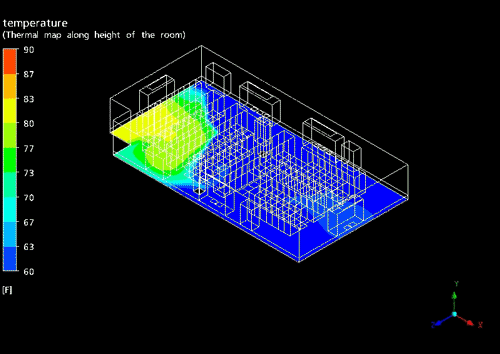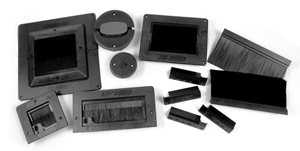The size and shape of a data center can impact the ability of Computer Room Air Conditioning (CRAC) systems to adequately cool the heat loads. Larger rooms will typically require a greater number of CRAC units due to limitations on air delivery of the units. So, although a single unit may have the BTU (British thermal unit) capacity to cool a given load, it may be unable to effectively deliver the cool air if the load is spread out in a large room resulting in inadequate data center cooling.
Odd shapes and obstructions also present air delivery problems and can be especially problematic when trying to achieve redundancy of CRAC units. These limitations apply mostly to traditional CRAC units which deliver air through a raised-floor plenum or overhead ductwork. In-row cooling solutions can overcome some of these limitations since the units are placed close to the heat load, and redundant units can be placed in the rows, as well. Raised-floor applications with traditional CRAC units, fan-tray supply diffusers and return-air fan products can improve air delivery, redundancy, and efficiency.
Data centers or server rooms with alcoves, L shapes, or two large rooms connected in a disjointed fashion also create problems. Consistently, we find these are really two separate environments with little in common when it comes to airflow and cooling. In cases where moderate-density equipment has been placed in an alcove or other similarly obscured part of the room, some type of assisted or active airflow is usually necessary to move cooling in, move heat out, or both.
Ceiling Height 
Whether ceiling height affects cooling largely depends on how well the room is laid out. If there is a proper hot aisle/cold aisle layout with CRACs placed at the ends of the rows with at least 36-inch wide hot aisles and 48-inch wide cold aisles, a ceiling as short as 8 feet can work. It's difficult at 8 feet to use overhead cable trays, however, so a 9-feet minimum is recommended to keep data cables out of the raised floor.
If the room does not have a proper hot aisle/cold aisle layout, then more ceiling height will help promote a lower resistance path to the CRAC returns. In this case, higher ceiling heights can also be used to promote a stratification layer where hot air collects at the top. The CRAC returns can be raised up to at least 2 feet below the ceiling to collect the hottest possible air. If there is a suboptimal layout and a low ceiling, then active airflow devices can come into play to force the air away from its "lazy path" and direct it to racks or CRACs as needed.
Gauging a Room's Coolability
There are many factors to gauging a server room's coolability, but they all come down to how efficiently the right amount of cooling can be delivered from the cooling units to the rack intakes, and then how efficiently the warm air can make its way back to the cooling unit returns. The enemy at all times is the mixing of hot and cold air.
The following factors should be considered when determining a data center's coolability:
- CRAC orientation. The CRACs should be at the ends of the rows to allow cooling and heat to flow easily in and out of the rows with the minimum amount of mixing.
- Raised floor height. As a general rule, a 10,000-square-foot data center should have a minimum of 2 feet. Smaller sites can get by with less; larger sites need more.
- Underfloor obstructions. Obstructions close to CRAC units cause the most problems. As you get farther away from the CRACs, they become less intrusive. Cable trays and other large obstructions should be limited to the hot aisles if possible.
- Shape. Square or rectangular rooms will usually be easier to cool.
 Floor cutouts. These should be small enough so that excess air is not leaking out to spaces that don't need cooling, if you do have them you should be using brush sealed raised floor grommets to control the leaking.
Floor cutouts. These should be small enough so that excess air is not leaking out to spaces that don't need cooling, if you do have them you should be using brush sealed raised floor grommets to control the leaking.- Ceiling height. It is often difficult to get good return air paths below 9 feet.
- Ducted ceiling returns or containment. These always improve the coolability of a data center when properly engineered. Special attention must be paid to local fire code enforcement, which varies widely.
- Blanking panels. These prevent recirculation of hot air from the back to front of a rack. If there is not enough CFM (cubic feet per minute) being delivered to the front of the racks, blanking panels won't help.
What shape is your data center or server room? Have you already put some of these best practices to work and if so, have you seen better data center cooling results?

